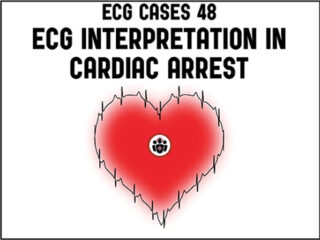Most Recent
ECG Cases 48 – ECG Interpretation in Cardiac Arrest
In this month's ECG Cases blog Dr. Jesse McLaren reviews interpretation of the pre-arrest ECG: identifying high risk ECGs requiring empiric treatment like calcium for hyperkalemia, magnesium for long QT, or reperfusion for Occlusion MI; the intra-arrest ECG: identifying pseudo-PEA; and post-arrest ECG: the importance of serial ECGs to reduce false positive STEMI, role of POCUS to help with the differential of diffuse ST depression with reciprocal ST elevation in aVR, and identifying signs of Occlusion MI/ false negative STEMI...
EM Quick Hits 54 Button Battery Ingestion, C. difficile, ECG in Tox, Bed Bugs, Fibrinogen in Trauma, Cold Air for Croup
Olivia Ostrow on the management of button battery ingestions, Brit Long on C difficile infection, Jesse McLaren on an approach to ECG's in the tox patient, Joe Mullally on the identification and treatment of bed bug bites, Andrew Petrosoniak on fibrinogen replacement in bleeding trauma patients, Justin Morganstern on Cold Air for Croup... https://emergencymedicinecases.com/donation/
Ep 190 Carpal Bone Injuries – The Big 4
Triquetrum chip fractures, scapholunate injuries, hook of the hamate fractures, and of course, scaphoid fractures can be easily missed with serious consequences for our patients. In this part 2 of our 2-part podcast series on wrist injuries we highlight the "Big 4" most commonly missed and mismanaged carpal bone injuries, elucidating the key historical, physical exam and x-ray findings, as well as management strategies...
EM Cases Best of 2023 Top 10
Based on a blend of number of listens, feedback from listeners, website visits and personal faves, EM Cases Best of 2023 Top 10...
ECG Cases 47 – ECG Interpretation in Toxicology
In this ECG Cases Dr. Jesse McLaren delves into ECG interpretation in toxicology and the poisoned patient using his HEARTS approach in 7 case examples. Heart rate/rhythm: consider antidotes for brady/tachy-arrhythmias, and for sinus tachycardia consider fluids for vasodilation and benzodiazepines for agitation. Electrical conduction and axis: consider sodium bicarb for QRS > 100 especially if RBBB or terminal rightward shift, and magnesium for QTc> 500. ST/T changes: consider the differential including demand ischemia, associated electrolyte abnormalities, Brugada pattern from sodium channel blockade, and acute coronary occlusion vs vasospasm from cocaine...
Ep 189 Commonly Missed and Mismanaged Wrist Injuries
In this part 1 or our 2-part podcast series on wrist injuries Dr. Arun Sayal and Dr. Matt DiStefano answer such questions as:when should we suspect a DRUJ injury, why is it important to pick up DRUJ injuries in the ED, and how does it change our management? Why is the lateral x-ray view so important in picking up commonly missed wrist injuries? When it comes to distal radius fractures, how are Colles vs Barton's vs Smith's fractures managed differently in the ED? What are the 2 key x-ray signs we should look for on the AP and the 2 key x-ray signs we should look for on the lateral for every wrist injury? and many more...







